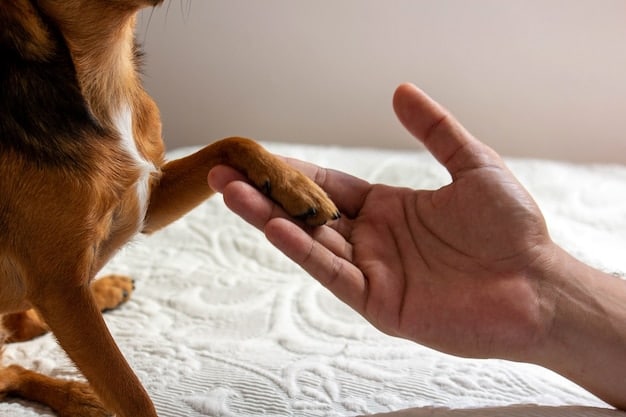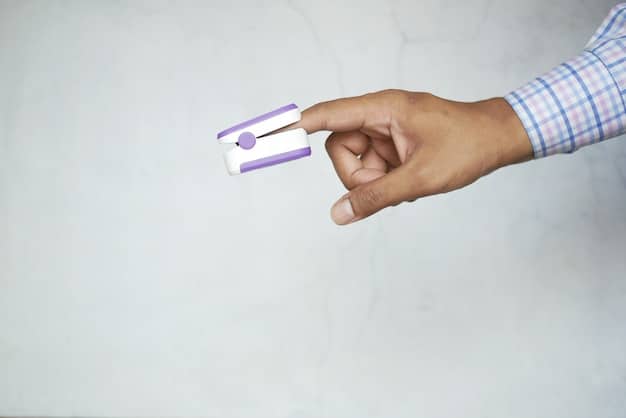Unlock a Well-Behaved Dog: Positive Reinforcement Techniques That Work

Anúncios
Positive reinforcement techniques are a proven method for training dogs, focusing on rewarding desired behaviors to encourage repetition and create a positive learning environment, essential for a well-behaved and happy canine companion.
Unlocking the secret to a well-behaved dog often seems like a daunting task, filled with conflicting advice and frustrating setbacks. But what if the key to a harmonious relationship with your furry friend lay not in punishment, but in the power of positivity? Discover the secret to a well-behaved dog: positive reinforcement techniques that actually work.
Anúncios
Understanding Positive Reinforcement in Dog Training
Positive reinforcement isn’t just about giving treats; it’s a comprehensive communication strategy that helps your dog understand what you want them to do. It’s about building trust, strengthening your bond, and creating a positive learning environment where your dog thrives.
At its core, positive reinforcement involves rewarding your dog immediately after they perform a desired behavior. This reward, whether it’s a tasty treat, enthusiastic praise, a favorite toy, or even a simple pat on the head, reinforces the behavior, increasing the likelihood that your dog will repeat it in the future.
Anúncios
Key Principles of Positive Reinforcement
To truly master positive reinforcement, it’s important to understand the underlying principles. Timing, consistency, and clear communication are crucial for success. Here are some things to consider.
- Timing is Everything: Reward your dog immediately after the desired behavior. Even a few seconds delay can confuse them.
- Consistency is Key: Use the same cues and rewards consistently. This helps your dog learn faster and avoids confusion.
- Clear Communication: Be clear about what you want your dog to do. Use simple, concise commands and avoid ambiguity.
By understanding these core principles, you can lay a solid foundation for effective and rewarding training sessions with your dog. It’s not just about giving treats; it’s about creating a positive learning experience that strengthens your bond and helps your dog thrive.

In conclusion, positive reinforcement is a powerful and effective way to train your dog because it fosters a positive attitude towards training. It allows you to communicate your expectations clearly and rewards your dog for achieving success.
Choosing the Right Rewards for Your Dog
Selecting the right rewards for your dog is crucial in the success of positive reinforcement training. Not all dogs are motivated by the same things, so it’s important to understand your dog’s individual preferences and tailor your rewards accordingly.
The most common type of reward used in positive reinforcement is food. Treats should be small, tasty, and easy for your dog to eat quickly. High-value treats, such as small pieces of cooked chicken or cheese, can be especially effective for more challenging behaviors or in distracting environments.
Beyond Food: Exploring Different Types of Rewards
While food is a popular choice, it’s important to remember that rewards aren’t limited to edibles. Many dogs are highly motivated by other forms of reinforcement. Here are some things to try.
- Praise and Affection: Verbal praise, petting, and cuddling can be powerful motivators for many dogs.
- Toys: A favorite toy, such as a ball, squeaky toy, or tug rope, can be used as a reward during training.
- Playtime: A short game of fetch or tug-of-war can be a great way to reward your dog and build their enthusiasm.
The most effective approach is to mix rewards together, so you can vary them to suit the situation at hand. For example, the high-value treat can be used in a new area to maintain focus, but affection and praise can be used in the house.
By carefully selecting rewards that appeal to your dog’s unique preferences, you can dramatically increase the effectiveness of your positive reinforcement training.
Effective Positive Reinforcement Techniques
Now that you understand the principles of positive reinforcement and how to choose the right rewards, let’s explore some specific techniques that you can use to train your dog effectively.
These techniques, backed by numerous studies, can establish healthy boundaries and habits. Remember: consistent use of positive reinforcement is key to success.
Luring and Shaping: Guiding Your Dog to Success
Luring and shaping are two powerful methods for teaching new behaviors. Here’s how they work:
- Luring: Use a treat or toy to guide your dog into the desired position. For example, hold a treat near your dog’s nose and move it slowly over their head to encourage them to sit. As they sit, say “Sit” and give them the treat.
- Shaping: Reward successive approximations of the desired behavior. Start by rewarding any movement in the right direction and gradually raise the criteria until your dog performs the full behavior.
One example of is the “stay” command. Start by rewarding your dog for simply remaining still for a second. Gradually increase the duration of their stay, rewarding them for each small increment of improvement.
Clicker Training: Precision and Clarity
Clicker training is a powerful technique that can enhance positive reinforcement by providing a clear and consistent signal to your dog. It’s a tool that marks the exact moment your dog performs the desired behavior, making it easier for them to understand what they did right. The key to this methodology is pairing the sound of the clicker with a reward, typically a treat. This associates the sound with something pleasant, turning the clicker into what’s known as a conditioned reinforcer. With time, the sound alone becomes enough to encourage your dog.
When using a clicker, be sure to adhere to these rules:
- Always follow the click with a reward, even if the behavior wasn’t perfect.
- Click only once per behavior. Avoid multiple clicks, which can confuse your dog.
- Keep training sessions short and fun to prevent boredom and maintain your dog’s interest.

Through consistency and patience, these positive reinforcement techniques can transform your dog’s behavior, and solidify the bond between you and your furry friend.
Addressing Common Training Challenges
Even with the best positive reinforcement techniques, you may encounter challenges along the way. Understanding how to address these issues effectively is key to maintaining progress and preventing frustration.
Don’t let setbacks derail your efforts. With persistence and a positive attitude, you can overcome these challenges and achieve your training goals.
Dealing with Stubbornness and Resistance
Sometimes, dogs may seem stubborn or resistant to training. This can be due to a variety of factors, such as a lack of motivation, confusion about the desired behavior, or underlying anxiety.
Consistency is Key
Ensure everyone in the household is using the same commands and rewards, preventing confusion. Review and possibly refine your training if you are facing resistance.
- If your dog is not responding to rewards may increase the value of the reward. If you’re using kibble, try switching to a high-value treat like cooked chicken or cheese.
- Simplify the behavior into smaller steps that are easier for your dog to understand.
- If your dog is showing signs of anxiety, such as panting, pacing, or lip licking, take a break and try again later.
By addressing stubbornness and resistance with patience, understanding, and a willingness to adapt your approach, you can keep your dog engaged and motivated throughout the training process.
Maintaining a Positive Training Environment
Creating and maintaining a positive training environment is just as important as the specific techniques you use. A positive atmosphere fosters trust, reduces stress, and makes learning more enjoyable for both you and your dog.
A calm and encouraging environment will also make it easier for your dog to focus on the important aspects of the training without getting distracted. Here are some ways to make that happen.
Setting the Stage for Success
Consider scheduling training sessions at times when your dog is most alert and receptive. Avoid training when your dog is tired, hungry, or distracted. Also, try these other tactics.
- Choose a quiet and familiar location with minimal distractions.
- Keep training sessions short and sweet, typically lasting no more than 10-15 minutes.
- End each session on a positive note, with a behavior your dog knows well.
Even if you stick to the prescribed rules, remember that progress isn’t always linear. Some days your dog might do well, other days, not so much. Embrace the ups and downs, and focus celebrations on the progress made over time.
By prioritizing a positive training environment, you can foster a strong bond with your dog and make training a fun and rewarding experience for both of you.
Advanced Positive Reinforcement Strategies
Once you’ve mastered the basics of positive reinforcement, you can explore more advanced strategies to further enhance your dog’s training and behavior.
These techniques require patience, consistency, and a deep understanding of your dog’s individual needs and learning style. With those foundations, you will be well on your way.
Generalization and Maintenance: Ensuring Long-Term Success
Generalization involves teaching your dog to perform a behavior in different environments and situations. Maintenance ensures your dog continues to perform learned behaviors over time.
Tips on Using Generalization Well
Start by practicing the behavior in a familiar location and gradually introduce distractions. Then, practice the behavior in different locations, such as your backyard, a park, or a friend’s house. Incorporate other training partners into the system to further enforce the habits.
- Regularly practice learned behaviors, even if your dog already knows them well.
- Periodically reward your dog for performing learned behaviors to reinforce them.
- Be patient and understanding, and don’t get discouraged if your dog occasionally forgets or struggles with a behavior.
By gradually generalizing behaviors and consistently maintaining them, you can ensure your dog remains well-behaved in all situations and environments.
| Key Point | Brief Description |
|---|---|
| 🐶 Timing is Key | Reward your dog immediately after the desired behavior. |
| 🦴 Reward Variety | Use different rewards like treats, praise, and toys. |
| 🐾 Consistency | Always use the same cues for commands. |
| 👍 Positive Environment | Keep training sessions fun and encouraging. |
Frequently Asked Questions
▼
Positive reinforcement involves rewarding desired behaviors to encourage repetition. This method focuses on creating a positive learning environment for your dog, improving engagement and trust.
▼
Effective rewards aren’t just limited to treats. Many dogs respond well to praise, toys, or playtime. Experiment to find what motivates your dog the most for better results.
▼
When facing resistance, ensure commands are clear and consistent. You might need to simplify tasks or increase the reward value. Patience and adapting your approach are essential.
▼
Keep training sessions short and engaging, typically 10-15 minutes. This helps maintain focus and prevents boredom, making each session effective and enjoyable for your dog.
▼
If you are running into a consistent wall with training, consult a professional trainer. They can offer custom solutions to work effectively with your dog.
Conclusion
By implementing these positive reinforcement techniques, you can cultivate a well-behaved dog while building a strong, loving relationship. Remember to stay consistent, patient, and positive, and celebrate every success along the way. The journey to a well-behaved dog is a rewarding one, filled with love, trust, and companionship.






